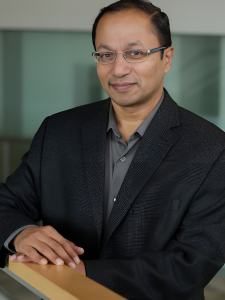Presented By: Michigan Institute for Computational Discovery and Engineering
Large Eddy Simulation of Turbulent Cavitating Flows
Krishnan Mahesh, Professor, University of Michigan Naval Architecture and Marine Engineering

Abstract:
Cavitation is a complex multi-scale phenomenon that has implications from intense sound production to erosion in engineering applications. This talk will discuss our efforts at developing the large-eddy simulation capability for the simulation of turbulent cavitating flows. LES of cavitation is challenged by phase change modeling, acoustic stiffness, sharp multiphase fronts, strong compressibility effects, consistent accounting of nuclei, broadband turbulence and subgrid effects.
LES of partial cavitation will be discussed under the same conditions as experiments in a sharp wedge configuration. Physical mechanisms of cavity transition observed in the experiments, i.e., re-entrant jet and bubbly shock waves, are both captured in the LES over their respective regimes. Vapor volume fraction data obtained from the LES will be quantitatively compared to X-ray densitometry, and the results will be discussed. Cavitation nuclei are likely to be introduced through the free-stream as well as at solid surfaces. We will present a novel approach based on Gibbs free energy minimization to predict nuclei concentrations. The results from the proposed work will be applied to account for dissolved gas content in CSM measurements and predict several decades of experimentally observed trends in nuclei concentrations. Cavitating flows possess a range of vapor length scales ranging from tiny vapor bubbles to large vapor pockets. We will discuss a compressible hybrid model to capture both sub-grid vapor nuclei and massive sheet cavity dynamics. Finally, physical aspects of inception due to the interaction of a counter-rotating vortex pair generated behind a pair of hydrofoils will be presented.
Cavitation is a complex multi-scale phenomenon that has implications from intense sound production to erosion in engineering applications. This talk will discuss our efforts at developing the large-eddy simulation capability for the simulation of turbulent cavitating flows. LES of cavitation is challenged by phase change modeling, acoustic stiffness, sharp multiphase fronts, strong compressibility effects, consistent accounting of nuclei, broadband turbulence and subgrid effects.
LES of partial cavitation will be discussed under the same conditions as experiments in a sharp wedge configuration. Physical mechanisms of cavity transition observed in the experiments, i.e., re-entrant jet and bubbly shock waves, are both captured in the LES over their respective regimes. Vapor volume fraction data obtained from the LES will be quantitatively compared to X-ray densitometry, and the results will be discussed. Cavitation nuclei are likely to be introduced through the free-stream as well as at solid surfaces. We will present a novel approach based on Gibbs free energy minimization to predict nuclei concentrations. The results from the proposed work will be applied to account for dissolved gas content in CSM measurements and predict several decades of experimentally observed trends in nuclei concentrations. Cavitating flows possess a range of vapor length scales ranging from tiny vapor bubbles to large vapor pockets. We will discuss a compressible hybrid model to capture both sub-grid vapor nuclei and massive sheet cavity dynamics. Finally, physical aspects of inception due to the interaction of a counter-rotating vortex pair generated behind a pair of hydrofoils will be presented.